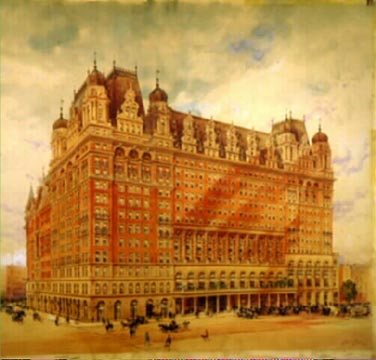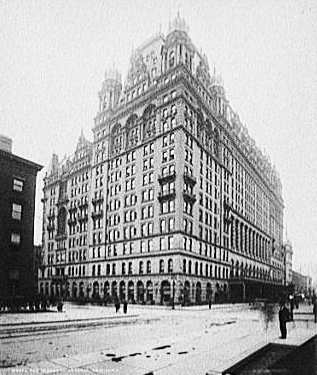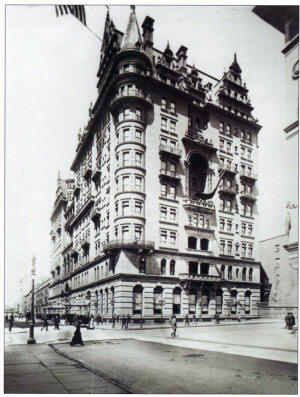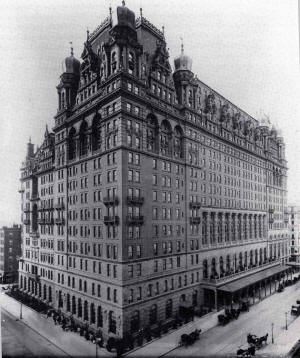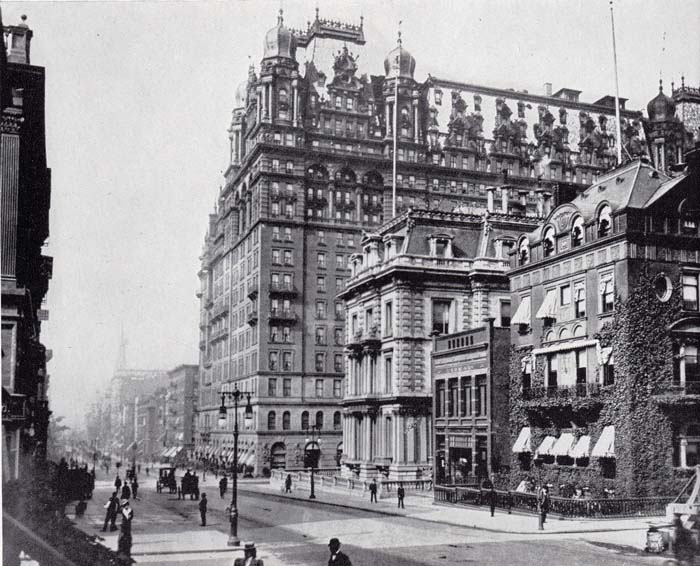|
notes
|
In 1890 William Waldorf Astor
decided to raze the family mansion on the corner of Fifth Avenue and
33rd Street and commissioned Henry J. Hardenbergh to build the largest,
most luxurious hotel in the world. The 13 story Waldorf Hotel, with 450
rooms, opened in 1893 and was instantly the talk of the town. Its
success inspired John Jacob Astor, William’s cousin, who owned the other
half of the block, to demolish his house and build an adjacent connected
hotel. The Astoria, also designed by Hardenbergh, was combined with the
Waldorf in 1897 to form the Waldorf-Astoria. The hotel was not just for
travelers—in its 40 public rooms the fashionable society of New York
gathered, dined, and entertained. The staff numbered nearly as many as
the 1,500 guests that registered daily in its 1,300 rooms. Hardenbergh
built many of New York’s grand hotels and apartment buildings of that
era, including the Dakota Apartments (1884) and the Plaza Hotel (1906).
The Waldorf-Astoria Hotel was demolished in 1929 to make way for the
construction of the Empire State Building. The hotel’s refined Art Deco
successor soon rose on Park Avenue between 49th and 50th Streets.
The corridor connecting the two buildings
became an enduring symbol of the combined Waldorf and Astoria hotels,
represented by the quirky "=" the Waldorf=Astoria uses instead of a
hyphen in its official logo. In 1929 the original Waldorf-Astoria was
demolished to make way for the Empire State Building.
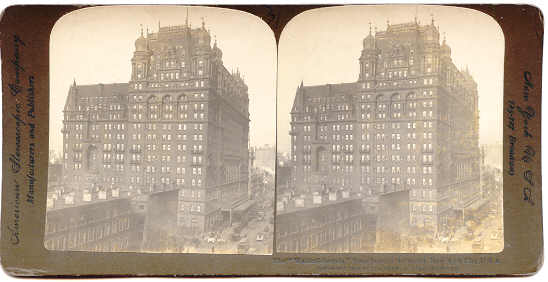 |
|
|
|
~The
Waldorf-Astoria~ |
|
|
|
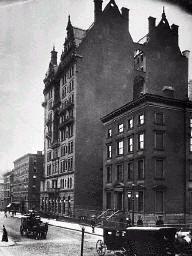 |
|
|
|
In 1890, John Jacob Astor III bequeathed his home to his son,
William Waldorf Astor, who decided not to live in it. He chose
instead to live on the northeast corner of Fifth Avenue and 56th
Street. It was not William’s intent to live next door to his “Aunt
Lina”, with whom he’d been engaged in a family feud for several
years. As far as William was concerned, he was the
male head of the Astor family, and therefore, it was his
wife, Mary Dahlgren Paul (called Mamie) who was to be referred to as
“THE
Mrs. Astor”! It infuriated him that, due to her high social
standing, the press and Society had fallen into the habit of
referring to his aunt as “Mrs. Astor”. Frankly, Caroline herself
regarded the entire matter with simple indifference, but as William
had since childhood considered himself to be superior, and had
always been ill-tempered and spoiled, his intent was to seek revenge
against his aunt. Thus, he decided that rather than live
in the house next door to her, he would build a large, noisy hotel
on the corner of Fifth and 33rd Street that would drive his aunt
crazy, and would literally overshadow her! William Waldorf insisted
that the hotel be named “The Waldorf” so as to always remind the
public of his importance. Yet, by the time of the hotel’s
completion in 1893, Waldorf had been living in England for two
years. He saw his hotel only once in his lifetime. |
|
|
|
|
 |
|
|
|
|
The Waldorf
opened its doors on March 4, 1893 and was a smashing success. The
grand-opening event was a fund-raising party for the benefit of St.
Mary’s Free Hospital for child-ren. The event was sponsored by some
of the most prominent and well-known names of the upper social
circles. The patroness (benefactor) was Mrs. Richard Irwin, who was
one of the original “Four Hundred”, and was active in unlimited
charities. Mrs. William K. Vanderbilt (also a Fifth Avenue resident
and the topic of the next entry on this webpage) paid for the
opening concert, performed by the New York Symphony led by Walter
Dam-rosch. |
|
|
|
Not only did The Waldorf prove to be very profitable for the Astor
estate, it also accomplished William’s underlying purpose of driving
his Aunt Lina out of her home at 350 Fifth Avenue. In actuality,
however, Mrs. Astor had begun contemplating her move from 350 Fifth
Avenue at the very onset of plans for the Waldorf Hotel in 1890. At
that time, rumors began floating that the residence of Caroline
Schermerhorn Astor might be demolished and the site used for a
sister hotel. When William Waldorf moved to England in 1891 (two
years prior to the grand opening of his hotel), Caroline’s son, John
Jacob Astor IV, became the titular head of the Astor family, and
plans for the building of a second hotel became official. The
hotel was originally to be called “The Schermerhorn”, in tribute to
his renowned mother, but in the end, the hotel was named in honor of
Astoria, the fur-trapping colony in Oregon where the Astor wealth
originated. |
|
|
|
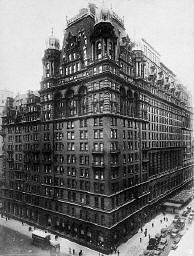 |
|
|
|
|
|
The Astoria had a frontage on Fifth Avenue, but its length was along
34th Street. At sixteen stories, the Astoria stood five stories
taller than the Waldorf, but the two hotels were connected and in
effect, became one building.
The combined hotel (for which provisions were made that the hotels
could be divided at any time; most likely a carry-over from the
uneasy relations between the two branches of the family) became
known as the Waldorf-Astoria, and was the largest
hotel in the world at its opening on November 1, 1897. |
|
|
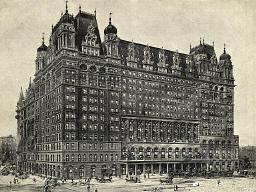 |
|
|
|
|
|
|
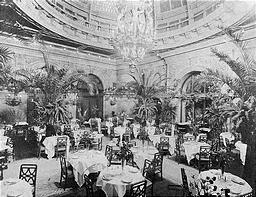 |
|
|
In 1900, Harper’s Bazaar described the Waldorf-Astoria as “the
fashion of New York and the Mecca of visitors...here is the chosen
gathering place of New York society, which comes here to see and to
be observed...”
And though society did go to the elegant Waldorf-Astoria for its
gatherings, they were choosing to live farther uptown, albeit still
on or near the most elite street of the Victorian Era: Fifth Avenue. |
|
|
|
|
|
|
Waldorf-Astoria's Interior "Palm Garden", 1902 |
|
|
|
|
|
With the death of William B. Astor in 1892, and the opening of the
Waldorf-Astoria hotel in 1893, Caroline Schermerhorn Astor felt that
a move uptown was not only inevitable, but also provident. After
conferring with her son, John Jacob Astor IV (who later died in the
1912 sinking of the Titanic), they contemplated the southeast corner
of Fifth Avenue and 55th Street as the site for her new home, but
decided against it because the neighbor-hood was simply too close to
the edge of commercial development and in danger of being swallowed
up by industrial growth. Therefore, it was determined that a better
site for the next Astor mansion would be the 75 X 100 foot lot on
the northeast corner of Fifth Avenue and 65th Street (which had been
purchased by William B. in 1891 for $215,000). This was indeed
grand foresight on the part of Mrs. Astor because, with the entrance
of Central Park laying at its doorstep, the area near the plaza at
59th Street and Fifth Avenue acted like a magnet for upper-class
development. |
|
|
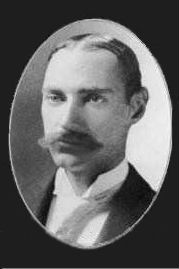 |
|
|
|
|
|
John Jacob Astor IV |
|
|
|
|
|
|
Renowned architect Richard Morris Hunt began to build the double
mansion for Mrs. William B. Astor and her son, John Jacob IV and his
family, and it was completed in January 1896. The double mansion
contained separate residences for Caroline and her son, but several
grand first-floor rooms that were used for entertaining linked
them. Among these rooms were drawing rooms, libraries, dining rooms
and breakfast rooms, in addition to a great hall that contained a
colossal double staircase. The opulent art gallery was situated in
the center of the house was transformed into a |
|
|
|
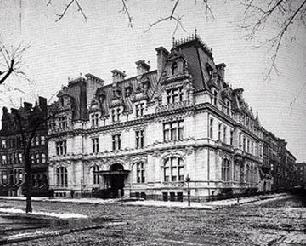 |
|
|
|
|
|
Astor Residence, 840 Fifth Avenue |
|
|
|
|
|
ballroom
that was used for the Astor’s’ frequent galas, receptions and
balls. Though the room could easily accommodate 600 guests, it did
not give rise to a new standard for society. The new ballroom never
quite saw the grand celebrations that the old ballroom at 350 Fifth
Avenue (which only held 400) had. |
|

